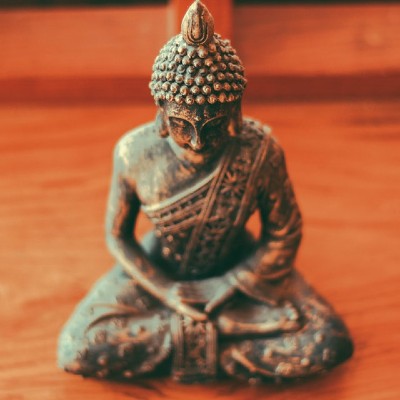Is there something we can do with pain besides cope through distraction, denial, wishful thinking, or numbing anesthetics? Is there a universal strategy that can be applied to all pains, regardless of their type, intensity, or causes? Is there a psychologically healthy way of making pain meaningful, a simple, systematic way to harness its energy in the service of life?
If there is, this would be very good news. We could then use the unavoidable discomforts of day-to-day life to foster personal growth. It would certainly be comforting and empowering to know that if we encounter major pain that cannot be relieved by any of the standard methods, there is another option available. Meditation represents such an option.
In order to understand the nature of pain and its relationship to the spiritual path, we must first discuss pleasure. Any pleasure we have can be experienced completely or not. When it is experienced completely, it yields satisfaction. Completeness has nothing to do with the intensity, type, or duration of the pleasure. Completeness requires just two elements: an unbroken contact with the pleasure and the absence of interference with it.
Not resisting pain is to have equanimity with the pain, radical self-permission to feel the pain.
Absence of interference means that the pleasure is not mixed with grasping, either conscious or subconscious. Grasping is a tension or viscosity that impedes the natural flow of the pleasure. It’s a kind of tightening around pleasure’s arising and passing. To experience pleasure without grasping is to experience it with equanimity—not aloof withdrawal but radical self-permission to feel the pleasure. Pleasure not mixed with grasping could be called pure pleasure. Pure pleasure purifies consciousness and permanently raises our base level of appreciation for life.
The situation with pain is perfectly parallel to that of pleasure. Any given pain can be experienced either completely or incompletely. When it is experienced completely, it is not experienced as suffering; it does not become a problem. Does it hurt? Yes. Does that eclipse the perfection of the moment? No. Complete pain means pure pain, pain not mixed with resistance, either at the conscious or subconscious level of neural processing. Resistance is inner friction that interferes with the natural flow of pain. Not resisting pain is to have equanimity with the pain, radical self-permission to feel the pain. Pure pain purifies. The “matter” of the pain becomes converted into energy that massages and softens the very substance of the soul.
Let’s try to make this process more tangible. In the undistracted meditative state, if pain arises, you can clearly observe the interaction of the pain and your resistance to it. For example, an uncomfortable sensation may arise in your knee as you’re meditating. At the same time, you may observe that in reaction to the pain, you are clenching and tightening other parts of your body, while in your mind a stream of judgments and aversive thoughts are erupting.
The sensation in your knee is the pain. The tension is your bodily resistance. The judgments are mental resistance. The resistance can be distinguished clearly from the pain itself. As you consciously relax the tension and drop the judgments, even though the pain level is the same, it seems to be less of a problem. Later, when the resistance returns, you notice that the pain has again become a problem. So once again you drop the judgments and stop the clenching, and the sense of suffering diminishes, even if only slightly. But you are making your first steps in learning how to experience pain skillfully.
Subsequent steps involve letting go of progressively more subtle mind and body resistance, until the deep subconscious resistance begins to break up. At that point the pain starts to flow. It feels like you’re being massaged and nurtured. You experience the pain working on your consciousness at a very deep level. It is as though your consciousness were dough and the pain wave is kneading that dough, working out the lumps and kinks, transforming it at a molecular level into something soft, pliant, and malleable. With continued practice, this skill becomes internalized and integrated into your being. When you encounter discomforts in the course of daily life, you automatically let go into equanimity.
Is it necessary to experience discomfort in order to deepen one’s spiritual practice? Absolutely not! The skills that allow us to experience pleasure with heightened satisfaction are the same ones that allow us to experience pain with diminished suffering. Skill with pleasure leads to skill with pain, and vice versa, because what we’re really learning is how to feel. If discomfort arises during meditation, we can take measures to relieve it or we can explore it. The choice is ours. If we encounter pain in daily life that cannot be relieved, then we have no choice, since the only alternative to experiencing it skillfully is to experience it as abject suffering.
In this life we must sometimes spend time in purgatory, an uncomfortable place of spiritual purification. If we understand how to meditate, then the purgatory won’t turn into hell, a terrifying place of meaningless suffering. From the perspective of spiritual growth, there’s a big difference between hell and purgatory. Either way, the idea of voluntarily staying with pain may still seem a little radical. Please remember that we are talking about working with small, manageable doses of subjective discomfort that do not objectively harm the body. And yes, this is a radical thing to do. From Latin, “radical” means addressing an issue at the root, the most basic level.
When we sit and meditate, we may sometimes be subject to discomforts, aches and pains, sleepiness, body sensations of agitation and impatience, itches, and awkwardness from the posture. These discomforts are real but quite manageable. In the meditative state, we can experience them with more mindfulness and equanimity than we do in daily life. In meditation the mind and body go through a natural change, a deep learning process that affects the unconscious levels of neural processing. The deep mind learns a healthy way to deal with pain. As a result, when we encounter real pain in the real world, we discover that we are not suffering the way we used to. By not suffering, I mean that the pain does not obscure the perfection of the moment, does not distort our perception or behavior, does not alienate us from our spiritual source or from our fellow beings.
Article from Lion’s Roar, March of 2007. Reprinted with permission from the author.



